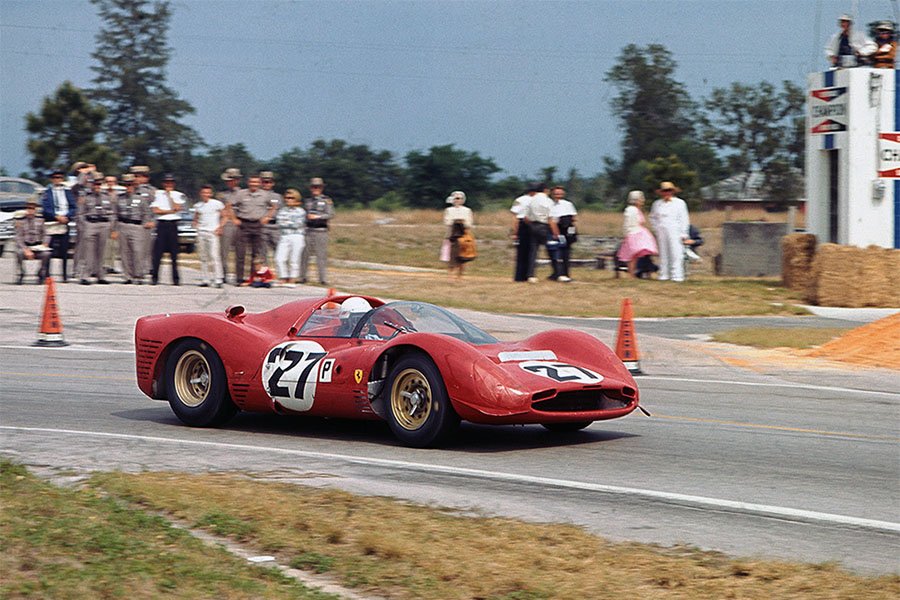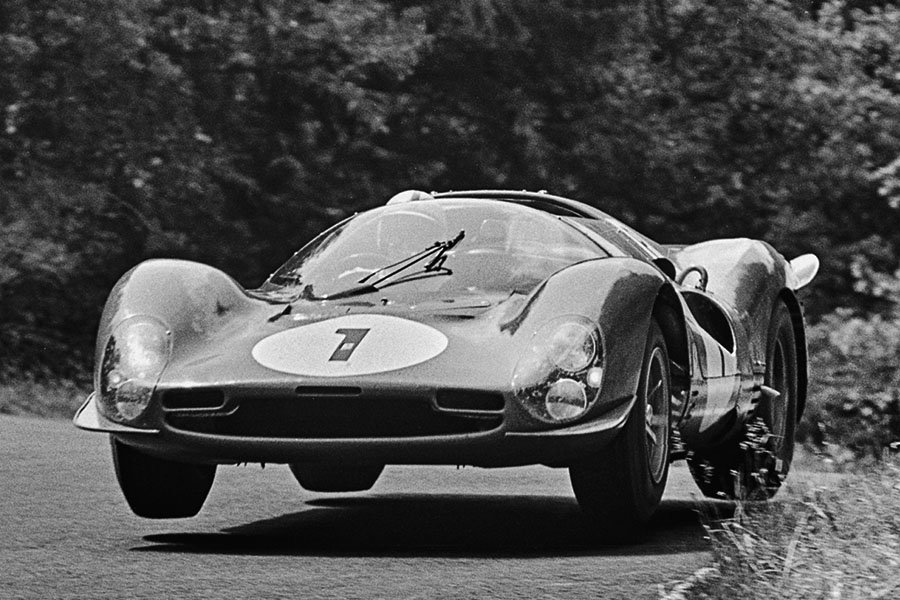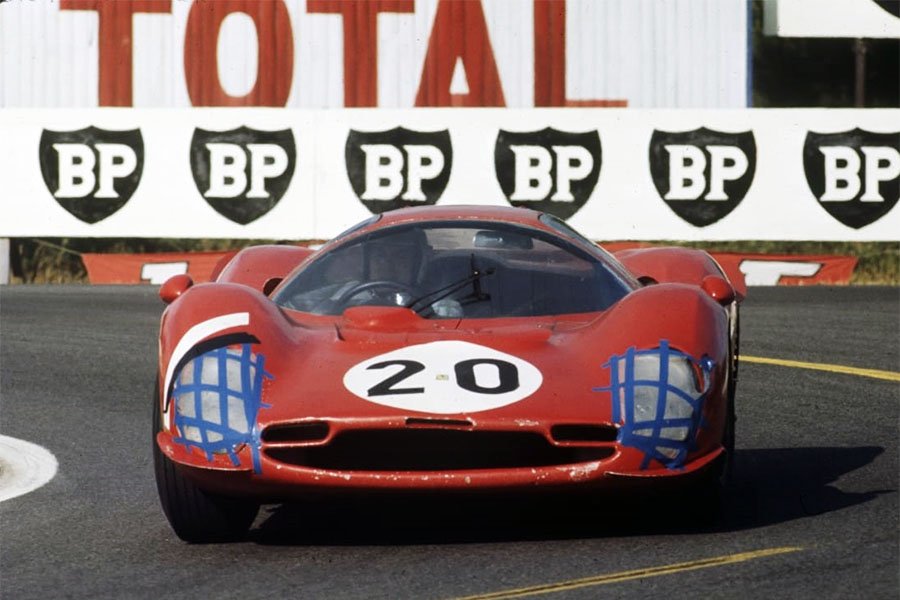Guide: Ferrari 330 P3 - a Historical & Technical Appraisal
/BACKGROUND
Having vowed to defeat Ferrari at the Le Mans 24 Hours following the collapse of a takeover bid, Ford’s debut campaign with the GT40 in 1964 had seen the car show a devastating turn of speed but dismal reliability.
Things improved significantly in 1965 when the GT40 won its first major race (the season-opening Daytona 2000km), but otherwise Ferrari retained its status as the dominant force in top flight sportscar racing.
For 1966, the FIA implemented some major changes to the World Sportscar Championship which since 1962 had been decided by production-based Grand Touring cars. Alongside the GT cars, purpose-built machinery had contested a limited number of the World Championship’s blue ribband events, the points from which went towards a separate championship for prototype machinery.
That would all change for 1966 when the FIA’s new Appendix J regulations were ushered in. From now on the main event, the International Manufacturers Championship, would be decided by Group 6 Prototypes split into over and under two-litre classes. Group 6 had no minimum production requirement and the championship would be contested over seven races (eight in the case of under two-litre cars).
Running simultaneously at most events (and with several stand alone races for the smaller engined machinery) was the International Sports Car Championship for Group 4 cars. To qualify for Group 4, a manufacturer had to build 50 examples of the vehicle they wanted to race. The three Group 4 classes were for under 1300cc machinery, those with engines between 1301cc and 2000cc, and those displacing over 2000cc.
Group 3 Grand Touring cars were still permitted to run at most events, but were no longer eligible for championship points. Significantly, the minimum production requirement had been hiked from 100 to 500 vehicles.
The premier over two-litre class of the 1966 International Manufacturers Championship for Group 6 Prototypes comprised the Daytona 24 Hours, Sebring 12 Hours, Monza 1000km, the Targa Florio, Spa 1000km, Nurburgring 1000km and Le Mans 24 Hours. However, only a manufacturer’s best four results would count towards their final points tally.
To tackle the growing threat from Ford (who were known to have a further refined seven-litre Mk2 GT40 in the pipeline), Ferrari created the new 330 P3.
The P3 was reserved strictly for use by the works team while Ferrari’s satellite squads (run primarily by their distributor teams) would be supplied with P2s that had been brought up to P2/3 specification and which ran less complex single overhead camshaft engines.
Ferrari also came up with a new under two-litre Group 4 challenger for 1966: the Dino 206 S.
Both the P3 and Dino 206 S were unveiled at Ferrari’s Maranello press conference in February 1966.
Unfortunately though, labour strikes were paralysing Italy at the time which led Ferrari to attend their first five races of 1966 with a single P3 entry while the ambitious 50 car homologation target for the Dino 206 S never came close to being achieved.
CHASSIS
The P3 was based around a new Tipo 603 tubular steel spaceframe chassis reinforced with riveted aluminium panels to create a semi-monocoque effect. A 2400mm wheelbase was carried over from the P2. The engine and gearbox were now an integral part of the structure along with a bonded fibreglass underside that extended into to the rocker panels. As a consequence, torsional rigidity was much-improved.
Suspension was broadly similar to the P2 with unequal length wishbones, coil springs, adjustable shocks and anti-roll bars.
Vented disc brakes were supplied by Girling and mounted inboard of the differential at the rear.
Centre-lock 15-inch diameter Campagnolo cast alloy wheels were wider than before (8.5-inches front, 9.5-inches rear). Firestone tyres were normally used instead of Dunlop.
A 57-litre fuel tank was housed in each sill for an overall capacity of 114-litres (down from 140-litres in the P2).
ENGINE / TRANSMISSION
In the engine bay was another dry-sump four-litre DOHC 60° V12 of Colombo-lineage. Unlike the P2 (which had used both 3.3-litre ‘275’ and 3.3-litre ‘330’ engines) the P3 only ever ran with a four-litre power unit.
The P3’s Tipo 216 motor was the first engine from Maranello to feature Lucas fuel-injection as opposed to Weber carburettors. It also came with twin spark ignition, redesigned lightweight cylinder heads and a higher compression ratio (increased from 9.9:1 to 10.5:1).
Displacement was 3967cc thanks to an unchanged bore and stroke of 77mm and 71mm respectively.
Peak output was 420bhp at 8000rpm (up from 410bhp at 8000rpm).
No torque figure was originally published.
Transmission was through a five-speed Tipo 593 gearbox, a triple-plate Borg & Beck clutch and a limited slip differential.
BODYWORK
The P3’s bodywork was a natural evolution of the curvaceous P2 from 1965.
At the front of the car was a wide oval intake that housed a pair of supplementary brake ducts in each corner and a slim central vent to reduce air pressure. On either side were new stacked headlights mounted under contoured Plexiglas covers.
A domed windscreen gave a panoramic view from the cockpit. Ferrari created a roof-less Spyder variant with a flattened central rear deck and a Berlinetta with a fully enclosed Fastback-style rear screen.
Cooling slots were cut from both ends of the sills, from the doors, behind the rear wheels and also the rear apron. The tail fascia was home to a pair of massive meshed cutaways that enabled hot air to escape from the engine bay.
Overall, the P3 was 90mm shorter, 95mm wider and 90mm lower than the P2.
Body panels were fabricated from the thinnest gauge aluminium at Carrozzeria Sports Cars of Modena run by Piero Drogo.
INTERIOR
The P3’s interior had two tiny seats squeezed in between substantial sills and a tall central divider. The seat bolsters, the sills and the divider were trimmed in black vinyl and the seat centres were bright red.
A simple crackle black dash housed read outs for engine speed, road speed and oil pressure located within small cowls directly ahead of the driver. Additional gauges for battery voltage, oil temperature, water temperature and fuel were located off to the left.
Every P3 was built in right-hand drive with a right-hand gear change.
WEIGHT / PERFORMANCE
Weight was 850kg.
If configured with the appropriate gear ratios, a top speed of 193mph and 0-62mph time of under 4 seconds were possible.
PRODUCTION
Ferrari built three examples of the P3 for 1966.
Chassis 0844 was a Berlinetta that contested three races (Monza, Spa and Le Mans).
Chassis 0846 was a Spyder that contested four races (Sebring, the Targa Florio, the Nurburgring and Le Mans).
Chassis 0848 was a Berlinetta that contested one race (Le Mans).
1966 SEASON
Scuderia Ferrari had a fine roster of drivers at its disposal for 1966 to include Mike Parkes, John Surtees, Ludovico Scarfiotti, Nino Vaccarella, Lorenzo Bandini, Jean Guichet, Pedro Rodriguez, Bob Bondurant and Mario Casoni. Together they would take the challenge to the Ford and Chaparral teams.
Ford announced early on that they would officially target just three rounds of the International Manufacturers Championship with the Mk2 GT40. Those events were the Daytona 24 Hours, Sebring 12 Hours and Le Mans 24 Hours.
By contrast, Ferrari would attend every race bar the season-opener at Daytona where the Fords finished first, second, third and fifth. The best-placed Ferrari had been NART’s 365 P2 which took fourth in the hands of Pedro Rodriguez and Mario Andretti.
The P3 made its competitive debut at the Sebring 12 Hours on March 23rd. Mike Parkes and Bob Bondurant started from second in chassis 0846 behind the works Mk2 GT40 of Dan Gurney / Jerry Grant. Five other GT40s were among the other top ten qualifiers along with two Chaparrals.
Having led for much of the first hour, the P3 subsequently occupied second and third positions depending on stops for fuel and driver changes. It was lying second when Bondurant became stranded out on the circuit with a seized gearbox at three quarter distance. The Fords finished first, second and third.
Scuderia Ferrari chose not to attend the annual Le Mans Test in early April and claimed they were happy to conduct their high speed running at the Monza 1000km, but the decision was most likely dictated by labour disputes.
John Surtees returned to the fray in Monza – his first race back since a near fatal accident at the Canadian GP Can-Am race the previous September. In the absence of any works Fords or Chaparrals, Surtees and Parkes took a commanding win in Italy driving P3 Berlinetta chassis 0844.
Scuderia Ferrari entered their P3 Spyder for the Targa Florio on May 8th (chassis 0846). It was allocated to Vaccarella / Bandini and supported by a brace of works Dinos. Ford and Chaparral were once again absent which meant the biggest threat to a Ferrari victory came from the five car Porsche works team with their squad of two-litre Group 6 906s.
The event saw the P3 battle it out with the experimental eight cylinder 906 of Gunther Klass / Colin Davis until Bandini hit a kerb at two thirds distance and crashed the P3 while in second position. The more fancied pair of Porsches also fell by the wayside after making contact with one another which resulted in a victory for the 906 of Willy Mairesse / Herbert Muller. The Dino of Guichet / Baghetti finished second and won its class.
Ferrari went on to score a dominant lights-to-flag victory with the P3 Berlinetta (0844) at the Spa 1000km two weeks later (May 22nd). Despite the presence of an Alan Mann Racing Mk2 GT40 for John Whitmore / Frank Gardner (running in preparation for the British team’s outing with the seven-litre Ford at Le Mans) Parkes and Scarfiotti completely dominated proceedings to take the P3 Berlinetta’s second win from two outings. The Ford finished a distant second.
John Surtees and Mike Parkes were behind the wheel of the P3 Spyder (0846) for the final International Manufacturers Championship race prior to Le Mans: the Nurburgring 1000km on June 5th.
They started from pole ahead of the Chaparral 2D of Jo Bonnier / Phil Hill which was making its European debut. However, while Surtees pulled clear of Bonnier during the first hour, the P3 came in soon after for an unscheduled stop to get a replacement rear shock absorber fitted.
Having dropped well down the order, Parkes manoeuvred the P3 back into eighth before the rear suspension collapsed just after Surtees had taken the wheel for his second stint. A clutch failure at three quarter distance put 0846 out for good as the Chaparral was chased home by a brace of works Dinos.
With two wins apiece for Ford and Ferrari, the 1966 International Manufacturers Championship would be decided on the result of the Le Mans 24 Hours which took place over the weekend of June 18th and 19th.
For this event, Ferrari had a trio of P3s in attendance for Parkes / Surtees (0848), Guichet / Bandini (0844) and Rodriguez / Ginther (0846). Unfortunately, a disagreement between Surtees and team manager Eugenio Dragoni saw the Englishman walk out. He was replaced by reserve driver Ludovico Scarfiotti.
Despite the presence of four P2/3s from Ferrari’s satellite teams, the race was a disaster for the Maranello outfit. Scarfiotti wrecked 0848 when he smashed into a near stationary Matra soon after midnight, Rodriguez / Ginther went out shortly before mid-distance with gearbox failure while lying fourth and the much-delayed Bandini / Guichet machine blew a head gasket during the 17th hour having limped round with an overheating engine for quite some time.
Thanks to a famous 1-2-3 finish at Le Mans, Ford won the 1966 International Manufacturers Championship by 38 points to Ferrari’s 36.
SUBSEQUENT HISTORIES
During the winter of 1966-1967, all three P3s were rebuilt.
Chassis 0844 was converted into a 412 P and sold to NART.
Chassis 0846 was converted into a 330 P3/4 and retained by Scuderia Ferrari.
Chassis 0848 was converted into a 412 P and sold to Scuderia Filipinetti.
Text copyright: Supercar Nostalgia
Photo copyright: Ferrari - https://www.ferrari.com & The Henry Ford Museum - https://www.thehenryford.org/








































